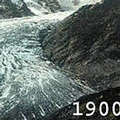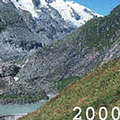 根據29日所公佈的最新資料指出,全球冰川融化速度越來越快,這份資料也證實過去25年來冰川正在快速地消失中。從2005年的初步數據來看,全球半數以上的冰山山脈平均融化了2/3公尺(26英吋)。
根據29日所公佈的最新資料指出,全球冰川融化速度越來越快,這份資料也證實過去25年來冰川正在快速地消失中。從2005年的初步數據來看,全球半數以上的冰山山脈平均融化了2/3公尺(26英吋)。
2005年冰河變化數據是由科學家記錄全球80處冰川變化整理而出,再回報給位於蘇黎士的世界冰河觀測局。
從1980年開始,科學家持續在9座冰山山脈測量30處冰川的厚度變化,這些冰川也就被視為參考指標。科學家表示,自1980年以來,這30處冰川的平均融化厚度約為10.56公尺(34英尺)。
 過去250年來,人類的活動將二氧化碳和其他溫室氣體排放至能阻擋太陽輻射的大氣中,導致全球氣溫升高。而這項對冰川群的長期監測,提供了定期全球氣候監控評估報告所需要的一項基本變數。
過去250年來,人類的活動將二氧化碳和其他溫室氣體排放至能阻擋太陽輻射的大氣中,導致全球氣溫升高。而這項對冰川群的長期監測,提供了定期全球氣候監控評估報告所需要的一項基本變數。
從2000年開始,這些冰川的年平均融化厚度約為每年2/3公尺。目前所測量到的冰層融化數值是1990年代平均值的1.6倍,更比1980年代融化速率快了3倍。
Mountain glaciers around the world are melting more and more quickly, according to new data issued today that confirms the trend in accelerated ice loss over the past 25 years. Preliminary figures for 2005 show an average thinning of the ice on the majority of the world's glaciated mountain ranges of two-thirds of a meter (26 inches).
The data on glacier change for 2005 was collected from 80 glaciers by scientists all over the world and reported to the World Glacier Monitoring Service, WGMS, in Zurich.
Since 1980, scientists have recorded continuous measurements of overall ice thickness change on 30 of these glaciers in nine mountain ranges, so these are considered to be the reference glaciers. The scientists report that since 1980 the average thickness loss of the 30 reference glaciers amounts to about 10.56 meters (34 feet).
Human activities over the past 250 years have emitted carbon dioxide and other greenhouse gases into the atmosphere, where they trap solar radiation close to the planet, raising the global temperature.
The long-term monitoring of glacier mass produces one of the most essential variables required for the regular assessment reports on global climate monitoring.
The average annual ice loss for the reference glaciers since the year 2000 was about two-thirds of meter each year.
This amount of ice loss is 1.6 times more than the average of the 1990s and three times the loss rate of the 1980s.
全文及圖片詳見 ENS報導







